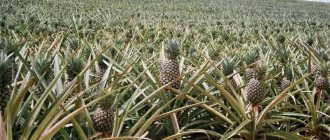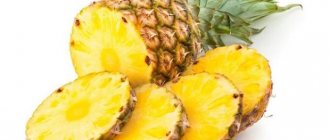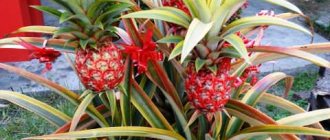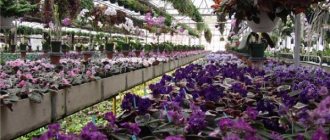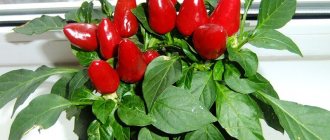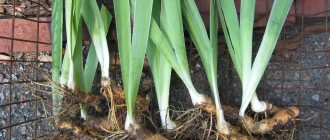It's hard to find a person who doesn't like pineapples. But few people know that you can grow this extraordinary fruit yourself. Let's figure out how to do this.
From seeds
Sowing by seeds is probably the most difficult of all growing methods. Those fruits that are sold in stores are usually collected at the stage of technical ripeness and are completely unsuitable for this planting option. You need to purchase mature pineapple seeds. They are dark brown in color and 3–4 mm in size.
Only mature sprouted seeds are suitable for planting pineapple.
Carry out preliminary preparation of the material for planting.
- Place the seeds in a humid environment for about a day. This could be a sponge or a wet wipe.
- For planting, take peat and sand in equal quantities.
- Bury the swollen seeds into the soil mixture no more than 2 cm.
- Pour warm water over everything and create a greenhouse effect. Use film, plastic bag or glass. Now they sell ready-made mini-greenhouses - they are perfect for germinating pineapple seeds.
A ready-made greenhouse for growing pineapple seedlings can be purchased at a garden store
Place the container in a warm place: the most favorable temperature is considered to be from 22 °C to 30 °C. The higher it is, the faster the seeds will germinate. You can put the greenhouse on the battery by placing a board under it. At average room temperature, the first shoots will appear in about a month.
A pineapple sprout at the three-leaf stage can be transplanted from the mother into a separate pot
Monitor the soil moisture and feed the seedlings once every 3 weeks. The grown seedlings must be planted into separate pots so that each young shoot turns into an independent fruit-bearing plant. As the seedlings grow, it is necessary to increase the volume of the pot so that the development of the root system in young shoots does not slow down.
Interestingly, all cultivated pineapples do not contain seeds, but if they are crossed with wild forms, they regain the ability to form them.
foodnews-press.ru
https://foodnews-press.ru/zdorovoe-pitanie/45-topy-foodnews-press/1028-top-20-interesnih-faktov-ob-ananasah
From the top
In order to grow a pineapple from the top, you need to choose the right fruit. Winter fruits are not suitable for this, because during transportation the rosette of the plant often freezes. A fresh fruit with a dense, healthy top is suitable. The leaves should be green, not dried out or spoiled. Stepping back 2–3 cm from the leaves, cut off the top.
It is necessary to cut off the top for planting, 2-3 cm away from the leaves.
Here are step-by-step instructions on how to prepare a pineapple rosette for planting:
- If the pineapple is ripe, try carefully unscrewing the socket. All the juicy pulp needs to be peeled off, as well as the lower leaves.
- The cut is treated against spoilage with a manganese solution. You can dry the top for one or two days to prevent rotting.
- To accelerate the formation and development of roots, treat the cuttings with growth stimulants (Epin, Kornevin). To do this, dip the top cut side into the prepared solution for 12–18 hours.
- For further germination, place the tuft in water, securing it to the surface. If the container with water is quite narrow, then the plant will support itself, due to the leaf rosette. If the seedling falls through, secure it with toothpicks or a cardboard circle with a hole in the middle.
- After waiting for the roots to appear, the top is transplanted into specially prepared soil.
Video: how to germinate the top of a pineapple at home
Ways to grow pineapple
In average climates, pineapples can only be grown in greenhouse conditions, greenhouses or on a windowsill. One of the reasons is the long cultivation of pineapple until a mature fruit is obtained. Several years, up to 4, pass in anticipation of the formation of an inflorescence. And it takes six months for the fruit to fill and ripen. Later, the plant dies, leaving behind numerous shoots, which are used to propagate the plant on an industrial scale.
At home, fruiting occurs after 26 months of plant development. After the fruit is removed, the plant dies, leaving many offspring with which it is propagated. In indoor conditions, the plant blooms 25 cm high and at the age of 16 months. Flowering will begin in two months and lasts two weeks. One flower blooms for 1 day. The fruit takes up to six months to form and ripen.
So, you can grow pineapple:
- seeds obtained from a ripe fruit;
- shoots from an adult or dead bush;
- the top of a ripe pineapple.
The seed propagation method is rarely used, as this is associated with an extension of the growing season. For those who like to start from scratch, you need to know that you can collect seeds from ripe exotic fruit. At home, cross-pollination requires that two adjacent plants bloom simultaneously. Subsequently, the seeds are sown in light soil and after germination they are grown to 6 cm and planted in a permanent pot.
Basic nuances of choosing a fruit
To plant a pineapple at home successfully, you need to prepare:
- a clay pot 3 liters deep and at least 15 centimeters wide;
- store-bought soil or homemade soil mixture;
- polyethylene film for covering;
- fetus.
Of course, before you start planting, you need to choose a well-suited pineapple fruit. First of all, it must be ripe. It is easy to calculate the degree of maturity by the color of the skin - it will be golden yellow, without gray spots. And the fruit itself should be elastic to the touch. A mature one may sag slightly.
Basic instructions from professionals on choosing the right pineapple will help you avoid mistakes in choosing:
It is important to pay attention to the sheets. A good quality pineapple will have an even green color and be firm. Fruit with yellow or brown leaves should not be taken. You need to pay attention to the aroma of the fruit
A sweet aroma will indicate its freshness. If the smell is sour, it is overripe. There is no need to buy this one. The moderate degree of elasticity of a pineapple indicates its quality. There is no need to choose an overly hard fruit. As well as being too loose, this indicates poor quality of the product.
And one last thing. It is best to choose pineapples in late August and early September. Experts recommend purchasing several pieces at once - all in different stores. This will help significantly increase the likelihood of successful rooting. If you buy pineapple in winter, you need to make sure that it is not frozen. This will not make it possible to grow a healthy plant with a good harvest.
It will require good care in the future. But choosing a quality pineapple is a fundamental point in the growing process.
The top of the pineapple must be very juicy and fresh.
It is imperative to pay special attention to the leaves. If they are too dry or stained, this can only indicate that the fruit is damaged by pests
This means that the plant itself can also become infected. The top should be deep green.
How to root correctly?
To grow a pineapple from the top as an indoor flower, the fruit must be divided and carefully processed. Otherwise, it will simply rot in the ground.
There are 2 ways to root a pineapple from the top:
- “crown” - a bunch of leaves with a core;
- apical part of the fruit.
It is difficult to say clearly which method is better.
Features of rooting tuft:
- It is easier to root a tuft at home, but after planting, only people who are well versed in the Bromeliad family can identify the plant by its leaves.
- A bunch of leaves reaching 70 cm in a small pot will be unstable, you will have to invent how to balance it. But the capacity you need is small.
Features of rooting apex:
- The top of the fruit is a little more difficult to root, but there will be no doubt that there is a pineapple in the pot. It is the opportunity to show off that often attracts flower growers when rooting store-bought fruit.
- Disadvantage: a plant grown at home from a cut top may rot. Especially if the pulp is not completely removed, or the wound is not healed well with callus.
Plant diseases
Lack of flowering for the first 3 to 4 years is not a problem if the pineapple looks good, increases in size, and receives everything it needs for growth - light and nutrition. If not cared for properly, green shoots will be signaled by a change in color. For example, yellowing and drying of foliage indicates a lack of lighting. This is especially true in winter, so you need to turn on the phytolamp.
When a crop loses its immunity due to lack of light or nutrition, it becomes weak and is attacked by fungal spores or pests. Under normal conditions, pests almost never damage pineapple, since its tissues contain substances that are unpleasant to insects.
Root rot and blackening of the stem are the result of overwatering. Cold water is harmful to tropical crops, especially in the summer. The plant becomes stressed and may respond by stopping growth.
If there is a lack of moisture in the air, the leaves dry out; without them, normal metabolism is impossible, so the plant dies. To eliminate pests or diseases, fungicides are used, as for ordinary indoor crops.
Propagation using root cuttings
Growing pineapple at home using root cuttings is more often practiced. Growing fruit this way is much easier than using seeds. But at the same time there should already be an adult plant at home.
For propagation, daughter shoots located at the bottom of the stem or under the infructescence are taken. The length of the cuttings should be at least 15 cm with several rows of leaves. The cuttings are rooted in the ground, and after new green leaves appear, they are transplanted to a permanent place.
Interesting facts about pineapple
When choosing an exotic fruit, you need to remember that this fruit does not ripen after it is picked. Therefore, there is no need to buy green pineapple - it will not become sweet.
Pineapple contains vitamins and nutrients in large quantities. This means that this fruit is good for health. In addition, the fruits contain bromelain, an enzyme with various beneficial properties. This enzyme has an anti-inflammatory effect and also breaks down fats perfectly. Therefore, pineapple is a valuable product for people who want to lose weight.
In some countries, even the leaves of the plant are used to make fishing nets and mats. With the help of modern technologies, environmentally friendly fabric is produced from pineapple leaves, which is becoming more and more popular over time. This fabric is used to make not only clothes, but also bags, shoes, etc.
Is it possible to grow a pineapple from the top: step-by-step instructions
You can grow a pineapple from the top. This is the fastest way to grow a plant, which is inferior to methods such as planting cuttings or seeds. For a successful landing, you need to complete several steps:
- Choose fresh pineapple from the store. A good, suitable specimen has elastic green leaves, hard skin, and a sweetish aroma. The fruit must not be eaten by midges. They often hide under the leaves of a plant.
- Remove the top of the pineapple. To do this, you need to cut off the top of the fruit (along with 4-5 centimeters of pulp). After this, you need to unscrew the leaves from the top of the fruit. The main thing is that there is no pulp left at all, otherwise the plant may begin to rot.
- The top of the pineapple must be turned upside down and left to dry for 1 week.
- Place the plant in water. The glass must be placed in a lighted place. In a few weeks, the top should acquire primitive roots. When the roots reach 5-6 centimeters, the plant can be planted in the soil.
- The plant is planted in the soil. In this case, its leaves should be on the surface. As a substrate, you can choose soil for cacti. The pot should be approximately 15 centimeters in height.
- Water the plant and place the pot in a warm, bright place. The soil should always be moist.
The plant takes a long time to take root. Rooting usually takes about 6 months. If all the rules of care have been followed, then after about six months the first flower will appear, from which the fruit will subsequently form.
Is it possible to grow pineapple at home not from the top?
There are several ways to grow pineapple. In addition to the top, you can use seeds. This method is complex and time-consuming, but some growers achieve good results. Therefore, the answer to the question of whether it is possible to grow pineapple at home in other ways is positive.
Seeds that you yourself extracted from a fresh pineapple are not suitable for planting. You can only use store-bought seeds.
The seeds, which can be used for planting, are brown in color and reach 4 mm in length.
- Before planting, seeds should be wrapped in a damp cloth for 24 hours.
- After the seeds have swelled, you can begin planting them in a mixture of sand and peat. The mixture should have been purified.
- Seeds should be planted to a depth of no more than 2 cm.
- The pot with seeds should be covered with polyethylene and placed in a warm place.
Seed germination depends on temperature. At normal room temperature, you can expect the first shoots to appear after 4-7 weeks. If the temperature is 30-33 o C, the first shoots will appear after 2-3 weeks.
In addition to maintaining the correct temperature, it is worth taking care of timely watering and fertilizing. The plant needs to be fed once every 3 weeks. It is best to use complex formulations.
Transferring a sprouted pineapple to soil for adult plants can be done when several leaves appear on the rosettes. The soil for replanting should consist of peat, sand, garden soil and humus in equal proportions.
Rules for caring for pineapple
It is not difficult to create comfortable conditions for pineapple. Required conditions:
- loose soil;
- proper lighting and humidity maintenance;
- watering and fertilizing according to schedule.
It is best to grow the plant on the eastern, western or southern windows of the house. At the same time, in the summer, when the sun coming through the window is especially hot, it is better to shade the pineapple. But in winter, when daylight hours are shortened, the owners of the exotic plant will have to take care of an additional 6-8 hours of lighting for the pineapple.
Pineapple does not tolerate cold. Therefore, a draft or watering with cold water is unacceptable. Also, you should not irrigate the leaves of the plant with water in winter.
Is it possible to grow pineapple at home ? Can! And believe me, this plant will not leave anyone indifferent. Follow the rules of care, and the evergreen pineapple will delight you all year round.
Indoor pineapple or pineapple in a pot
Growing at home is not particularly difficult. But following the rules of how to care is mandatory.
Decorative pineapple
This plant, when grown at home, does not always bear fruit. To obtain such a result, you need to carefully care for it. But it can be grown for decorative purposes. The way a pineapple looks can decorate your home. The rules for growing for decorative purposes are the same as in cases where you want to get fruit from a plant.
Germination
How to care for pineapple in a pot at home
Next we will tell you step by step how to grow a pineapple at home from the top.
For growing, you need to choose the right pot. It is believed that its volume should be such that at least 2 cm remains from the plant to the edge. In most cases, these are chosen for growing. So that their diameter is 12-14 cm.
A good sign is the appearance of new leaves in the rosette of the pineapple tree. In this case, you can be sure that rooting was successful.
For your information! This plant is mostly a herb rather than a fruit.
Growing
It is recommended to choose the sunniest place for the pineapple in the apartment.
In order for the plant to grow well, it needs to be replanted every year. It is preferable to perform this procedure at the beginning of the summer.
What do pineapples grow well on? They grow well in a variety of soil types. However, it is better for him to purchase soil in which palm trees are usually grown from a specialized store. It is acceptable to use universal primer.
When planting, it is necessary to add a drainage layer to the bottom of the pot, reducing the likelihood of excessive moisture and protecting the pineapple from root rot. Exot does not need to fertilize.
The plant will not bloom immediately. This usually happens 1.5-2 years after planting in the ground. If the pineapple is provided with abundant light, then fruits can develop from the flowers.
When growing, it is advisable to provide a temperature of 25°C for this heat-loving plant. It is most comfortable for pineapple during spring, summer and autumn. In winter, a temperature of 20°C is best.
Pineapple does not require a lot of moisture. In summer, it is enough to water 2-3 times a week. At the same time, you need to make sure that there is no waterlogging. In winter, it is enough to supply the plant with moisture weekly.
Note! When watering, pour a little moisture into the outlet. Spraying possible
When using tap water for this purpose, it must first be allowed to settle.
How to prepare and root a seedling?
Preparation and rooting of the top - step by step:
- How to trim the top. The top can be cut off with a sharp knife and any remaining pulp removed. However, it is better to hold the leaves with one hand and try to unscrew them from the fruit, like a screw. Rolling is quick and more effective than top trimming, since improper trimming can lead to rot. With one hand we grab the fruit, with the other we hold a bunch of leaves at the base and try to carefully twist it out of the fruit, as if unscrewing a jar. If successful, the leaves and conical base should remain in the bunch.
- You can remove a few of the lower leaves to expose the stem.
- The prepared apical seedling should be set aside for 2 weeks to dry.
- The pineapple tail is then placed in a vessel of water or wet sand. Place it on the south window. Rooting in water is a little more difficult because the fruits don't like a lot of moisture. It is important that the water remains below the level of the leaves. Sometimes you need to change the water, check the bottom of the outlet and the roots.
- It is important to maintain a high indoor temperature. At an optimal temperature of 25-30 degrees Celsius, germination occurs within 2 weeks.
How to choose the right planting material
To grow a healthy plant, it is important to choose the right fruit to extract the planting material - the green top.
The fruit must be:
- with leaves of rich green color and rigid structure;
- with golden yellow skin, without gray spots;
- with a pleasant sweetish odor;
- moderately elastic in density.
The best time to buy planting material is summer. You should not buy pineapples for planting in winter, as such fruits are often slightly frostbitten.
How to grow pineapple from seeds at home
Pineapple seeds can be extracted from ripe fruit or purchased at a flower shop. Externally, they have a dark brown color and are about 3–4 mm in size. To plant them you need to prepare:
- Rinse in a solution of potassium permanganate, then dry;
- Place in a humid environment for a day: sponge, napkin.
- Wait for the first roots.
- Prepare the pot and soil.
- After planting the plant, a greenhouse effect is created - the soil is covered with film or polyethylene.
It will take about 3 weeks for pineapple seeds to germinate, provided that they were stored at a temperature of 30 ° C. Growing a pineapple tree using seeds is quite an exciting activity, especially when the first rosettes and petals sprout from the soil.
Diseases and their symptoms
Exotic requires close attention, since it can be affected by parasites, causing illness and death. Most often, the plant is affected by spider mites, mealyworms, scale insects or phylloxera. To protect the flowerpot, it is periodically treated with a soap solution. It is enough to wipe the palm petals; you can also purchase a special pest repellent. It must be used as written in the instructions for use. There are several signs that the plant is sick:
- Drying leaves.
- Pale color of the plant.
- The top of the leaves are brown in color.
- Slow growth and lack of flowering.
- Leaves curl.
- Rot at the base.
The causes of such symptoms are not only pests, but also poor plant care. If the first signs of the disease appear, you should contact a flower shop, where they will find a remedy to save the plant.
Growing a pineapple at home is not easy, but if you follow all the rules, you can end up with a beautiful tropical representative at home and even try its fruits.
How to grow pineapple from seeds at home
Growing pineapple from seeds is a labor-intensive and time-consuming process. To do this, you need to purchase seed material from a specialized store. You won’t be able to get the seeds of this exotic fruit yourself. They are usually not ripe, and in hybrid pineapple varieties they are not present at all.
Pansies: caring for seedlings and in open ground
Rules for sowing pineapple seeds
The best time to sow seeds is spring, when nature is awakening and plants have enough light and warmth for active growth.
Pineapple seeds suitable for germination are 3–4 mm long and have a semicircular and flat shape and a reddish-brown tint. To prepare for sowing, they are placed in a warm place for a day, wrapped in a damp cloth. When the grains swell, they can be planted in the ground.
Here's how to properly plant pineapple seeds for seedlings:
- Fill a flat container with a light substrate of peat and sand (1:1).
- We disinfect the soil with a solution of potassium permanganate and let it dry a little.
- Scatter the seeds over the surface and cover the top with a thin layer of earth (1–2 cm), compacting slightly.
- Spray the surface with water from a spray bottle and cover the crops with film.
- Place the container in a warm place. At room temperature +18–25 °C, sprouts will appear only after 4–6 weeks. If you provide a temperature of +30 °C, the seeds will hatch in two weeks.
Planting cucumbers, growing, care in open ground
The greenhouse in which the exotic fruit grows is periodically ventilated. The accumulation of excess moisture can lead to the death of sprouts in the initial stage.
Growing pineapple from seeds: YouTube/Ivan Kirsanov
Caring for pineapple seedlings
After the appearance of two cotyledon leaves, the shelter is not immediately removed from the crops. The process of plant adaptation at home begins. Tender sprouts require hardening, so the film is first opened slightly for a few minutes and the hardening time is increased daily.
Caring for seedlings includes such points as:
- Planting into separate pots when the sprouts grow up to 5 cm. Only loose soil is suitable for seedlings. It can be purchased ready-made or mixed with peat, leafy soil and sand in equal proportions. To improve the soil composition and protect against infections, add 5% wood ash.
- Application of mineral complex fertilizing, including the necessary elements for active vegetation. Fertilizing is carried out with the appearance of three leaves two weeks after picking, and then once a month.
- Twelve hours of daylight. If natural light is not enough, phytolamps are connected.
- The mode of watering seedlings, which is carried out as the soil dries out, avoiding waterlogging. One watering every 7–14 days is enough. In summer, the leaves of the plant are additionally sprayed once every two days, removing excess moisture with a napkin.
- Certain temperature conditions. The author of the book “Pineapple” Elena Kurenkova believes that the active growth of a tropical plant in the spring-summer period occurs at a temperature of +25–30 °C. In winter, it is enough for him to maintain the temperature within +20 °C. Sudden temperature fluctuations and drafts should not be allowed.
- Annual replanting of perennials. In summer, an adult plant is transplanted into a large pot. One-year-old seedlings are transplanted by transshipment into 1-liter pots, and 2–3-year-old seedlings into 2.5–4-liter containers. You should not plant a small plant in pots that are too spacious, as the soil will become acidic. The roots do not reach all corners of the container, and the soil grows fungi, which lead to the death of the plant.
Tomato seedlings at home
Blooming pineapple bush: YouTube/Tatyana Kuzmuk
A pineapple bush bears fruit only once. After fruiting, which occurs in the third year of planting, the mother plant dies. It is necessary to transplant the side cuttings in time or propagate the indoor exotics again.
Growing pineapple at home is an accessible process for those who like to experiment with exotic plants. The time and effort spent will pay off with a generous harvest of juicy and aromatic pineapple fruits.
Be the first to know about everything
Subscribe and learn about the latest news from Kazakhstan, photos, videos and other exclusives.
Caring for indoor pineapple
Dear readers, to see how a pineapple blooms at home, you will have to work hard and be patient.
Before fruiting begins, it is important to create favorable conditions close to natural ones. . This is the result of painstaking work and care
This is the result of painstaking work and care
Temperature and light
Pineapple is a subtropical plant and will require a lot of sun and warmth.
- The acceptable temperature for pineapple growth is 25-28 degrees. At lower temperatures, development slows down and the bush withers.
- I placed the pot with the young seedling on the south window; the pineapple needs 12 hours of light. If it's cloudy and rainy, I use a fluorescent lamp.
- In the summer I take my pet out into the fresh air; he loves sunbathing.
Author's note Natalya Papanova Blog author
For the health of a young plant, take a phytolamp - it is an excellent growth stimulator.
Do you remember what light and temperature conditions are important for pineapple? Find out how to grow indoor pomegranate; this southern sunny fruit is also heat-loving, like pineapple.
How to water correctly and often
A rooted plant does not need frequent watering . Excess moisture has a detrimental effect on the roots.
But during flowering and fruiting, I water it abundantly (2-3 liters per bush) once every 3-4 days with warm (30-40 degrees) and settled water. I drain the remaining water from the pan an hour after moistening so that the roots do not rot.
Author's note Natalya Papanova Blog author
In the summer heat, I pour 1 glass of warm water directly into the outlet.
Don't like pineapple? Learn about caring for a tangerine tree, try cultivating vitamin-rich citrus to the surprise of your neighbors.
How to replant
After 1.5 months, new leaves appeared, which means it’s time to move the young plants to a larger container. I will share the secrets of transplantation.
Author's note Natalya Papanova Blog author
I increase the size of the new container by 2-3 cm and replant it in the summer.
- I poured 5 cm of expanded clay into a flat and wide pot for drainage.
- Filled to the top with disinfected soil composition.
- Using a spatula, I made a round hole 2.5 cm deep.
- I placed the seedling along with a lump of earth, pressed the soil around it to the base, the main thing was not to deepen the root collar too much to prevent rotting.
- I put it on the east window, where the sun is not so hot.
- After 2 months I moved it to the south windowsill.
Watch the video on how to transplant shoots from an adult plant.
Fertilizer and feeding
Friends, all cultivated plants need additional nutrition. Check out the pineapple fertilization schedule.
- To increase leaf mass, it is better to fertilize with nitrogen compounds immediately after rooting. I add 1 tsp to the root. ammonium nitrate diluted in 1 liter of warm water.
- After 14 days, I water it with the Pineapple mineral complex (according to the instructions for the product).
- If the pineapple is about to bloom, but does not gain any strength, I prepare a solution of calcium carbide (infuse 1 tablespoon in 1 liter of water for a day, close the jar with a lid).
- Before and after harvesting, it is advisable to feed the plant with organic matter: I water it with mullein once every 10 days (1 tablespoon of concentrate + 1.5 liters of water).
For an adult plant, additional nutrition is doubly important.
Have you finished exotic fertilizer? See if you can grow lychee at home and add another subtropical to your home garden collection.
How to care in winter
In winter, pineapple needs rest. Plant growers advise taking special care of it in winter.
- Water once a month.
- Do not spray.
- Do not feed until spring.
- It is better to place the bush in a cool place.
- If suddenly in the cold months a pineapple gets ready to bloom, organize a greenhouse for it and care for it as in the summer.
Choosing a pineapple variety together
Dear readers, before starting the experiment, I studied the conditions under which this ornamental plant grows and develops. It turns out that in order to break through the jungle and ripen safely, the pineapple needs a fire. The ashes are the favorite place for the pineapple family.
In order for a ripe pineapple purchased in a supermarket to produce a new bush, you will have to follow the rules of care and cultivation. I will describe the whole process step by step and tell you how to plant pineapple at home.
What kind of container is needed
I prepared several containers, because plants of different ages will require pots of different sizes.
- To grow the root system, I took a 5 liter bottle and cut off the top part. It is more convenient to monitor the condition of the seedling in a transparent container.
- When the roots hatch, I will transplant the pineapple into a pot with a diameter 2 cm wider than the seedling and a height of no more than 20 cm. Since the root system of the pineapple is located in the upper layers of the earth, a high pot is not relevant.
- As the plant grows, I will move it to a larger pot and so on up to 10 liters of volume - this is an ideal place for an adult bush.
- I treat all planting containers and tools with alcohol for disinfection.
Have you prepared the container for planting? Hurry up to learn how to store pineapple at home to preserve the future harvest.
Preparing the land for pineapple
The soil for the pineapple in the room will need ash. You can use universal soil for palm trees, but I prepare the soil myself.
- I mix sand, peat and turf in equal parts.
- I add 1.5 cups of wood ash per 5 liters, preferably from deciduous trees.
- I heat the earthen mixture in the oven at a temperature of 90 degrees so that pathogenic microbes die.
- I add 0.5 cups of dried banana peels and a complex of microelements (1 tsp urea + 1.5 tbsp superphosphate + 1 tsp potassium nitrate).
- I leave it to rest for 10 days.
Technology of planting seeds or tops
Dear friends, it is easier, of course, to plant a seed, but it is more interesting to root at the top, and the fruit will appear earlier.
Rules for choosing pineapple:
The ideal time to purchase is summer; if it is overcooled, the pineapple will not sprout.
- I choose a strong pineapple without spots or cracks.
- With a juicy-green top.
- With powerful leaves without mold or rot.
I cut off the top part with 1-2 cm of pulp so that the top does not crumble.
- I treat it with activated carbon powder (you can buy it at the pharmacy).
- I leave it in the open air for 3-4 days so that the cut dries and hardens.
- Then I plant it in a greenhouse from a 5 liter jar.
- I pour expanded clay onto the bottom of the greenhouse and a 5 cm thick layer of sand on top.
- I put the top in the sand.
- I strengthen the top with supports on both sides so that it does not fall.
- I cover it with film and secure it with an elastic band to seal it.
- I put it in a warm place.
Reproduction by dividing the bush.
After fruiting, the pineapple develops shoots, they are suitable for the formation of a new plant, look at the method of propagation.
- When the sprouts become 20-30 cm high, I begin division.
- Using a sharp knife, pre-treated with alcohol, I cut off the shoot at the base.
- I separate it so that some of the roots remain on it.
- I water the cut with a pink solution of manganese (1 crystal + 50 ml of water).
- I sprinkle it with ash and immediately plant it in the prepared soil.
- Using a transparent bag or film, I create a greenhouse for 1 month.
- I ventilate the entire period daily.
Seed planting technology.
- I soak the planting material for 20 minutes. in a 1% solution of phytosporin (1 drop + 10 ml of water).
- I rinse with boiled water.
- I plant the seeds in a peat pot for seedlings to a depth of 1 cm.
- I put it in a glass jar and cover it with a nylon lid.
- Germination temperature is 23-26 degrees.
Have you chosen the option of propagating pineapple? Then look at how to grow nectarine from a seed and place the healthy fruit on the window next to the pineapple.
Look at the video where the pineapple seed is located.
Preparing the soil and pot
The cutting will feel good in a low flower pot with a diameter of 30 cm. Pineapple roots do not go deep into the soil, but form in the upper layers. It is necessary to make holes at the bottom of the pot so that excess water does not stagnate in the soil.
In the future, for transplants you also need to choose low flowerpots, only with a larger diameter.
How are pineapples grown? Plants grow well in loose, nutritious soil. You can buy it at the store or prepare it yourself. You can mix peat and river sand in a ratio of 1:1 or leaf humus, turf soil, sand and peat in a ratio of 2:1:1:1
Flowering and fruit appearance
How to grow pineapples at home to get real fruits? The answer to this question is very simple: the plant needs to be properly cared for. In this case, homemade pineapple will bloom after 2.5 years of cultivation. Flowering of pineapple at home can sometimes be delayed, and this can happen for 3-4 years. If it is clear that the plant is already fully formed and ready to flower, it can be gently nudged to this step. To stimulate flowering, you can use several tricks:
- For half a liter of water, take 1 teaspoon of calcium carbide (it is often used by gas welders) and leave for 24 hours. After this, the liquid must be drained into another container, and the sediment and impurities must be left - they cannot be used. Every day for a week you need to pour 50 ml into the outlet itself. The pineapple will bloom in 1.5-2 months.
- Place a plastic bag over the pot with pineapple (so that a cap is formed). Place smoking coals nearby and leave them until they stop smoking. This procedure must be repeated 2 more times with a break of 1 week. After 2-2.5 months, flowers will appear on the plant.
- You need to put a bag on the pot and put a few apples or tomatoes there. They need to be changed from time to time.
After flowering, the plant will need 6-7 months to ripen the fruit. When the pineapple exudes a sweetish smell, it means the fruit is ripe and can be picked. On average, the weight of a fetus grown at home ranges from 0.3 to 1.5 kg. When the pineapple fruit grows, it can only be fed with organic fertilizer. Over the next 2-3 years, the plant will grow new shoots and then die. These new shoots can be replanted and several more pineapples can be grown. How to grow pineapples from root cuttings is described above.
Features and types of homemade pineapple
Under natural conditions, the plant reaches a meter in height and a diameter of two meters. In the room it grows only up to 70 cm. Adapted species:
| View | Peculiarities |
| bract | The leaves are a meter long, curved, bright green, with white and yellow stripes on their surface. When they fade in the sun, they turn pink and red. The tricolor look is popular in indoor floriculture. |
| Large-tufted | The linear leaves grow up to a meter, are arranged in a spiral, and form a spike-shaped inflorescence. The color of the flowers is purple, pink, red. |
| Dwarf | Dark green, narrow leaves, jagged along the edges, pointed at the end up to 30 cm. For ornamental cultivation only. |
| Shiny (black) | Long dark leaves at the edges with red, brown, bright green shades in the middle. |
| Champaka | Sharp, serrate leaves with conical pink inflorescences. |
| Decorative | Beautiful in appearance with bright bracts and variegated leaves in red shades. |
| Kaena | Up to 30 cm high, on a short stalk, edible fruits up to 5 kg in the shape of a cylinder. The leaves are not prickly, without thorns. |
| Sagenaria | Two-meter leaves, bright red fruits. |
| MD-2 | A hybrid with sweet, tasty fruits, resistant to diseases and pests. Widespread on shelves due to long-term storage. |
| Mauritius | It has excellent taste. |
Proper feeding: what, when and how
As soon as young leaves appear on the pineapple seedling, we begin to fertilize it regularly, once every 2 weeks, with a nutrient with a high concentration of nitrogen, potassium and phosphorus.
In summer, the plant should be fed every 2 weeks with liquid complex fertilizer. Pineapple absorbs nutrients in two ways: through leaves and roots, so it is sprinkled in the soil or on a rosette of leaves. It is better to use half the dose recommended by the manufacturer.
Feed your pineapple with an acidifying fertilizer for plants that love acidic soil. Apply them from May to the end of August.
Top planting
To grow a pineapple in an apartment, you must first plant it correctly. Step-by-step instruction:
- 2 days before planting, the soil should be spilled with boiling water or a pale pink solution of manganese.
- At the bottom of the container, it is important to make a drainage layer of 2-3 cm (expanded clay, pebbles, perlite, granite crushed stone).
- Fill the pot with prepared soil.
- Make a hole in the ground, place a cutting with roots there and add soil to the level of the leaves.
- Compact the soil a little and water the plant with warm water.
- After planting, the pineapple should be in a warm and very bright place, but the plant should not be exposed to direct sunlight.
- If the apartment is not too warm, then the seedling can be covered with a transparent glass jar, and when the first leaves appear, it should be removed.
- The top will take 1.5-2 months to take root at home.
Diseases and pests
Pineapple that grows at home is also not immune to diseases and pests. Mostly problems arise when care rules are not followed.
There may be several problems:
- The leaves began to dry. This happens when the room is too hot or the plant gets too much sunlight. To prevent the plant from drying out, it needs to be sprayed, watered if necessary and left in a cooler place.
- The leaves begin to turn pale and curl. This happens due to insufficient sunlight. You need to put the pineapple in a brighter place or add additional lighting.
- The trunk begins to rot. This occurs due to excess moisture, so you need to reduce watering until the pineapple is completely restored.
- A film appears on the leaves. This is a consequence of the life activity of the mealyworm. You need to apply a soapy solution, wash each leaf with it and treat it with Karbofos.
- Damage to the root system - a root worm has appeared. Here you need to stop watering and treat the soil with insecticides.
- A rosette in a thin web. This is the activity of a spider mite. The cobweb itself can be removed with a soap solution, and spider mites are killed by insecticides.
- The appearance of a sticky coating on the leaves. This is honey dew. To combat the disease, a soap solution is also used.
Thus, growing pineapple yourself at home is not as difficult as it might seem at first glance. This is a rather interesting process, although you will have to wait several years for the fruits to appear. How to grow pineapples at home is described in detail in this article; the main thing is to monitor watering and temperature conditions, because this is a southern plant. It is the correct care that will ensure the rapid ripening of the sweet, aromatic fruit right in the apartment.
